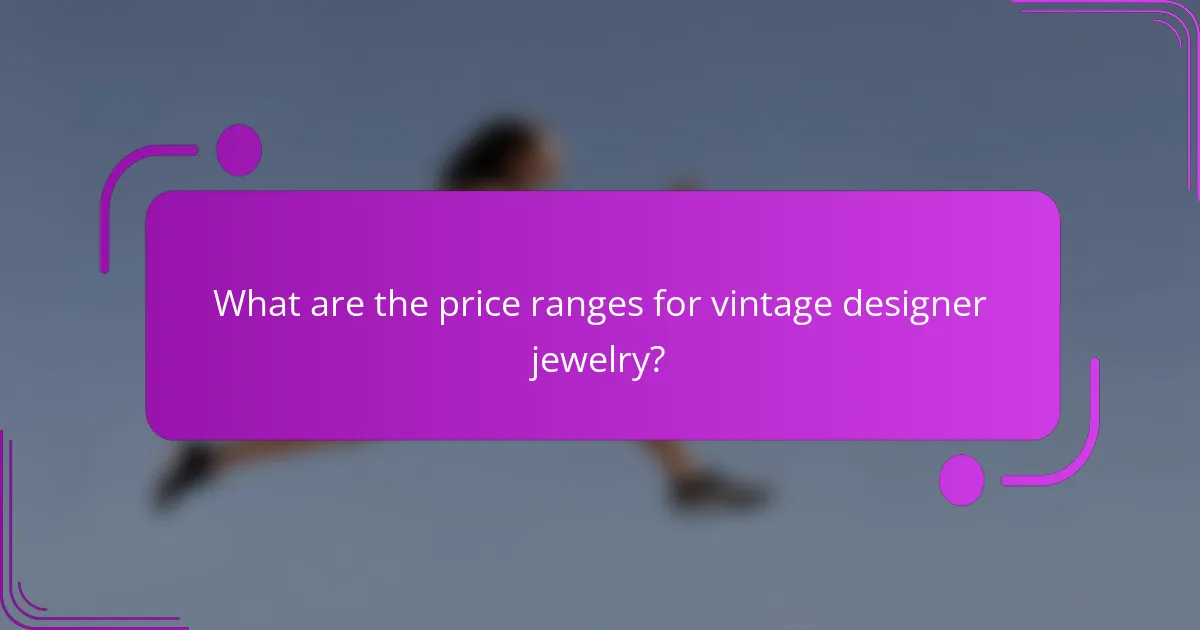Vintage designer jewelry comprises high-quality, unique pieces created by renowned designers before the 1980s, characterized by distinctive styles and exceptional craftsmanship. The article explores various styles, including Art Deco, Victorian, Edwardian, Retro, and Mid-Century Modern, highlighting their historical significance and artistic value. Additionally, it discusses the pricing range of vintage jewelry, which can vary from $100 to over $10,000, influenced by factors such as brand, age, condition, and rarity. The investment potential of vintage designer jewelry is also examined, noting its consistent appreciation in value, particularly for pieces from high-demand brands like Chanel and Cartier, making it an attractive option for collectors and investors.

What is vintage designer jewelry?
Vintage designer jewelry refers to high-quality, unique pieces created by renowned designers, typically made before the 1980s. These items are often characterized by distinctive styles and craftsmanship. Vintage jewelry is sought after for its historical significance and artistic value. Many pieces are crafted from precious metals and adorned with gemstones. Collectors value vintage designer jewelry for its rarity and potential to appreciate in value. Notable designers include Coco Chanel, Cartier, and Tiffany & Co. The demand for such jewelry has increased, making it a popular investment choice.
How is vintage designer jewelry defined?
Vintage designer jewelry is defined as jewelry created by renowned designers at least 20 years ago. This category includes pieces that reflect the artistic styles and craftsmanship of their respective eras. Vintage designer jewelry is typically characterized by unique designs, high-quality materials, and historical significance. Well-known designers such as Chanel, Cartier, and Tiffany & Co. often dominate this market. The value of these pieces can appreciate over time due to their rarity and desirability among collectors. Provenance and condition also play crucial roles in defining the quality and worth of vintage designer jewelry.
What criteria classify jewelry as vintage?
Jewelry is classified as vintage if it is at least 20 to 30 years old. This age criterion distinguishes vintage from antique jewelry, which is typically over 100 years old. Additionally, vintage jewelry often reflects the design styles and craftsmanship of its era. Common periods associated with vintage jewelry include Art Deco, Mid-Century Modern, and Retro. The materials used, such as gold, silver, and gemstones, also contribute to its classification. Collectors and appraisers often look for unique design features that characterize specific time periods. Provenance, or the history of ownership, can further enhance the vintage status of a piece.
What distinguishes designer jewelry from other types?
Designer jewelry is distinguished by its unique artistry, brand prestige, and limited availability. Unlike mass-produced jewelry, designer pieces often feature intricate designs and high-quality materials. They are created by renowned jewelry houses or individual designers known for their craftsmanship. This exclusivity enhances their value and appeal. Designer jewelry often comes with a signature or hallmark that signifies authenticity. The historical significance of certain designer pieces can also contribute to their desirability. Additionally, designer jewelry tends to appreciate in value over time, making it a viable investment.
Why is vintage designer jewelry significant?
Vintage designer jewelry is significant due to its historical value and craftsmanship. This type of jewelry often reflects the design trends and cultural influences of its era. It is typically made with high-quality materials and exceptional artistry. Many pieces are limited in production, making them rare and collectible. The provenance of vintage designer jewelry can enhance its value, as pieces associated with notable designers or celebrities are highly sought after. The demand for vintage items has increased, leading to rising prices in the market. Collectors view vintage designer jewelry as both an investment and a way to express personal style.
What cultural or historical importance does it hold?
Vintage designer jewelry holds significant cultural and historical importance as it reflects the artistic trends and social values of its time. Each piece often embodies the craftsmanship and design philosophies of renowned jewelers. These items serve as tangible links to past eras, showcasing the evolution of fashion and personal adornment. For example, Art Deco jewelry from the 1920s symbolizes luxury and modernity. Vintage pieces often carry stories of their original owners, connecting personal histories with broader cultural narratives. The market for vintage jewelry also highlights changing economic conditions and consumer preferences over decades. Collectors and historians value these items for their ability to convey historical context and cultural significance.
How has its popularity evolved over time?
Vintage designer jewelry has seen a significant evolution in popularity over time. Initially, its appeal was limited to collectors and enthusiasts in the mid-20th century. In the 1970s and 1980s, a resurgence occurred as vintage styles became fashionable among mainstream consumers. The rise of online marketplaces in the 2000s further increased accessibility, allowing a broader audience to explore vintage pieces. By the 2010s, vintage designer jewelry gained recognition as a viable investment, attracting investors seeking unique assets. Today, the popularity continues to grow, with vintage jewelry often featured in luxury fashion trends and high-profile auctions. This evolution reflects changing consumer values and a renewed appreciation for craftsmanship and history.

What styles of vintage designer jewelry are available?
Vintage designer jewelry is available in several distinct styles. Common styles include Art Deco, which features geometric shapes and bold colors. Another popular style is Victorian, characterized by intricate designs and romantic motifs. Edwardian jewelry often showcases delicate filigree work and is known for its elegance. The Retro style, prominent in the 1940s, includes bold, sculptural pieces with vibrant gemstones. Additionally, Mid-Century Modern jewelry emphasizes minimalist designs and innovative materials. Each style reflects the trends and craftsmanship of its time, making vintage designer jewelry unique and collectible.
What are the most popular styles of vintage designer jewelry?
The most popular styles of vintage designer jewelry include Art Deco, Retro, and Victorian. Art Deco jewelry is characterized by geometric designs and vibrant colors, popularized in the 1920s and 1930s. Retro jewelry emerged in the 1940s, showcasing bold designs and large gemstones. Victorian jewelry, from the 19th century, features intricate details and sentimental motifs. Each style reflects the cultural and artistic movements of its time. The demand for these styles remains high among collectors and enthusiasts. Historical significance and unique craftsmanship contribute to their enduring popularity.
How do Art Deco and Art Nouveau styles differ?
Art Deco and Art Nouveau are distinct design movements. Art Nouveau emerged in the late 19th century, characterized by organic forms and flowing lines. It often featured floral motifs and intricate details. In contrast, Art Deco developed in the 1920s and 1930s, emphasizing geometric shapes and bold colors. Art Deco designs are more streamlined and symmetrical. Art Nouveau focuses on craftsmanship and natural elements, while Art Deco embraces modernity and industrial materials. The two styles reflect different cultural contexts; Art Nouveau is associated with the Arts and Crafts movement, while Art Deco aligns with the glamour of the Jazz Age.
What characteristics define Mid-Century Modern jewelry?
Mid-Century Modern jewelry is characterized by its clean lines and geometric shapes. This style often features bold colors and innovative materials. Jewelry pieces from this era typically emphasize simplicity and functionality. Designers like Georg Jensen and Elsa Schiaparelli were influential in this movement. The use of non-traditional materials, such as plastics and resin, was common. Additionally, Mid-Century Modern jewelry often reflects a sense of optimism and forward-thinking design. The aesthetic aligns with the broader Mid-Century Modern design movement, which values minimalism and organic forms. Overall, these characteristics distinguish Mid-Century Modern jewelry as a unique and significant style in the history of fashion.
What materials are commonly used in vintage designer jewelry?
Vintage designer jewelry commonly utilizes materials such as gold, silver, and platinum. Additionally, gemstones like diamonds, rubies, and sapphires are frequently incorporated. Pearls and enamel are also popular in vintage pieces. These materials contribute to the craftsmanship and aesthetic appeal of the jewelry. Historical records indicate that gold was a preferred choice in many vintage designs due to its durability and value. Silver and platinum offered alternative options, each with unique characteristics. Gemstones were often chosen for their rarity and beauty, enhancing the jewelry’s allure. Pearls added elegance and were commonly used in necklaces and earrings. Enamel provided vibrant color and intricate designs, showcasing the artistry of the era.
How do gemstones influence the value of vintage pieces?
Gemstones significantly influence the value of vintage pieces. Their rarity and quality can enhance the overall worth of jewelry. High-quality gemstones, like diamonds or sapphires, often command higher prices. The historical significance of certain gemstones also adds to their value. For example, pieces featuring rare colored gemstones are highly sought after. Market demand for specific gemstones fluctuates, impacting prices. Vintage pieces with well-preserved gemstones retain value over time. Additionally, the provenance of gemstones can increase desirability and worth.
What role do metals play in the jewelry’s design and appeal?
Metals are fundamental to jewelry design and appeal. They provide structural integrity and durability to pieces. Common metals include gold, silver, and platinum, each offering unique aesthetic qualities. Gold is valued for its luster and resistance to tarnish. Silver is appreciated for its affordability and versatility. Platinum is favored for its rarity and strength. The choice of metal influences the overall style and price of the jewelry. Vintage pieces often feature specific metals that reflect historical trends. For example, Art Deco jewelry prominently used platinum for its sleek designs. Thus, the role of metals is crucial in defining both the visual and functional aspects of jewelry.

What are the price ranges for vintage designer jewelry?
Vintage designer jewelry typically ranges from $100 to over $10,000. Prices vary based on the brand, age, condition, and rarity of the piece. For example, costume jewelry can start at lower price points. In contrast, iconic pieces from renowned designers like Cartier or Chanel often command higher prices. Auction results show that some vintage pieces can sell for hundreds of thousands of dollars. The vintage jewelry market has seen significant growth, with certain items appreciating in value over time. This trend indicates a strong investment potential in the vintage designer jewelry sector.
How is the value of vintage designer jewelry determined?
The value of vintage designer jewelry is determined by several key factors. First, brand reputation plays a significant role. Renowned designers like Chanel or Cartier command higher prices. Second, rarity influences value. Limited editions or unique pieces are often more sought after. Third, condition is crucial. Well-preserved items with minimal wear fetch higher prices. Fourth, provenance adds value. A documented history of ownership can enhance desirability. Fifth, market demand fluctuates, impacting prices based on current trends. Lastly, materials used, such as precious metals and gemstones, also affect valuation. Collectors often refer to auction results and expert appraisals for accurate pricing.
What factors affect pricing in the vintage jewelry market?
The pricing in the vintage jewelry market is influenced by several key factors. Rarity significantly impacts value; limited availability increases demand. The condition of the piece is crucial; well-preserved items fetch higher prices. Designer labels also play a role; pieces from renowned designers are more sought after. Historical significance can enhance value; jewelry with a notable provenance is often priced higher. Market trends affect pricing; changes in consumer preferences can shift demand. Lastly, materials used, such as precious metals and gemstones, contribute to overall worth. Each of these factors intertwines to determine the final pricing of vintage jewelry.
How do brand reputation and rarity influence value?
Brand reputation and rarity significantly influence the value of vintage designer jewelry. A strong brand reputation enhances perceived quality and desirability. Consumers often associate well-known brands with superior craftsmanship and unique designs. This association can lead to higher prices in the market.
Rarity, on the other hand, increases exclusivity. Limited production runs or unique pieces create a sense of urgency among collectors. The scarcity of an item can drive up demand, further elevating its market value.
For example, a vintage piece from a renowned designer like Chanel or Cartier can fetch prices well above average due to both brand reputation and rarity. Historical auction results often show that rare items from prestigious brands achieve significantly higher bids.
What are typical price ranges for different styles?
Typical price ranges for vintage designer jewelry styles vary significantly. For example, Art Deco pieces typically range from $1,000 to $10,000. Edwardian jewelry often falls between $800 and $5,000. Mid-century styles can be found from $500 to $7,000. Vintage costume jewelry usually costs between $50 and $500. High-end pieces from renowned designers may exceed $20,000. Prices fluctuate based on factors like rarity, condition, and brand. Collectors often see value appreciation over time, making vintage jewelry a potential investment.
What can you expect to pay for Art Deco pieces?
Art Deco pieces can range in price from a few hundred to several thousand dollars. Factors influencing the price include the item’s condition, rarity, and designer. For example, a simple Art Deco ring may cost around $500. However, a rare piece by a renowned designer can exceed $10,000. Auction results show that high-quality Art Deco jewelry often fetches impressive prices, reflecting its enduring popularity. Overall, expect to pay a premium for well-preserved, unique items.
How do prices for vintage designer jewelry compare to modern pieces?
Prices for vintage designer jewelry often exceed those of modern pieces. Vintage jewelry is typically valued for its rarity and historical significance. Many vintage items are considered collectibles, driving up demand and prices. In contrast, modern pieces are mass-produced, which can lower their value. For example, a vintage Chanel piece may sell for thousands, while a new piece from the same brand may cost significantly less. Additionally, the condition and provenance of vintage jewelry greatly influence pricing. Collectors often seek unique vintage designs that are no longer available. This trend highlights the investment potential of vintage jewelry compared to modern alternatives.

What is the investment potential of vintage designer jewelry?
The investment potential of vintage designer jewelry is significant. This market has shown consistent growth over the years. According to a report by the Antique Jewelry University, vintage jewelry can appreciate in value by 10% to 20% annually. The rarity and brand reputation of specific pieces often drive their value. High-demand brands like Chanel and Cartier often yield higher returns. Auctions frequently feature vintage designer jewelry, indicating strong market interest. Collectors and investors view these pieces as both fashion items and financial assets. The historical significance and craftsmanship also add to their appeal.
How can vintage designer jewelry be considered an investment?
Vintage designer jewelry can be considered an investment due to its potential for appreciation in value over time. The rarity and desirability of specific pieces often lead to increased market demand. Historical significance and craftsmanship can further enhance their worth. For example, pieces from renowned designers like Tiffany & Co. or Cartier often fetch higher prices at auctions. According to a report by the Antique Jewelry University, vintage jewelry can appreciate by 10-20% annually. This makes it a viable alternative asset class for collectors and investors. Additionally, the unique attributes of vintage pieces can create a niche market, further driving value.
What historical trends indicate potential for appreciation?
Historical trends indicate that vintage designer jewelry has significant potential for appreciation. The demand for vintage pieces has increased over the last two decades. Auction results show that iconic brands like Chanel and Cartier have seen price increases of over 200% since the early 2000s. Economic factors also play a role; during economic downturns, luxury items often retain value better than other investments. Additionally, limited production runs and unique designs contribute to rarity, enhancing desirability. Historical sales data reveals that certain styles, such as Art Deco and Mid-Century Modern, have consistently outperformed the market. Collectors often seek pieces with provenance, further driving up prices. Overall, these trends suggest a robust market for vintage designer jewelry appreciation.
How does market demand affect investment potential?
Market demand directly influences investment potential by determining the value and desirability of assets. When demand for vintage designer jewelry increases, prices typically rise due to competition among buyers. This heightened interest can lead to higher returns for investors. Conversely, if demand decreases, the value of the jewelry may decline, resulting in potential losses for investors. Historical data shows that certain vintage pieces appreciate significantly during periods of high demand. For example, iconic brands like Chanel and Gucci often see their pieces fetch higher prices during fashion trends that revive interest in vintage styles. Thus, understanding market demand is crucial for making informed investment decisions in vintage designer jewelry.
What should buyers consider before investing in vintage jewelry?
Buyers should consider authenticity, condition, and provenance before investing in vintage jewelry. Authenticity ensures the piece is genuine and not a reproduction. Buyers can verify authenticity through certificates, appraisals, or expert evaluations. Condition affects both the value and longevity of the piece. Inspecting for damage, repairs, or wear is essential. Provenance provides historical context and can enhance value. Knowing the piece’s history, previous ownership, and any notable events can influence investment decisions. Additionally, market trends impact vintage jewelry prices. Researching current demand and popular styles can guide buyers in making informed choices.
How important is provenance in determining value?
Provenance is crucial in determining value. It refers to the history of ownership and authenticity of an item. In vintage designer jewelry, provenance can significantly affect market price. Items with well-documented histories often command higher prices. Provenance can authenticate the designer’s work and confirm rarity. For example, pieces owned by celebrities or featured in notable collections are more desirable. This desirability can lead to increased investment potential. The auction market frequently reflects this trend, with provenance driving bids higher.
What are the risks associated with investing in vintage jewelry?
Investing in vintage jewelry carries several risks. The primary risk is authenticity; counterfeit pieces can be difficult to identify. This can lead to financial loss if a buyer overpays for a fake item. Another risk involves market volatility; the value of vintage jewelry can fluctuate significantly based on trends. Additionally, condition issues pose a risk; damaged pieces may lose value or require costly repairs. Limited availability can also affect investment potential; rare items may not always be easy to sell. Finally, lack of expert knowledge can lead to poor purchasing decisions, increasing the likelihood of loss.
What tips can help you successfully invest in vintage designer jewelry?
Research the brand’s history and reputation. Established brands like Chanel or Gucci have proven value. Examine the condition and authenticity of the piece. Certificates of authenticity increase resale value. Understand market trends and demand for specific styles. Popular styles often appreciate more over time. Attend auctions and vintage fairs for unique finds. Networking with experts can provide valuable insights. Keep detailed records of purchases for future reference. Documentation aids in establishing provenance and value.
Vintage designer jewelry is defined as unique, high-quality pieces created by renowned designers before the 1980s, characterized by distinctive styles, craftsmanship, and historical significance. The article explores various aspects of vintage designer jewelry, including its definition, classification criteria, popular styles such as Art Deco and Victorian, and the materials commonly used. It also examines the investment potential of these pieces, discussing factors that influence their value, such as brand reputation, rarity, and provenance, alongside typical price ranges and market trends. Additionally, the significance of vintage jewelry in cultural and historical contexts is highlighted, providing a comprehensive overview of its appeal to collectors and investors.